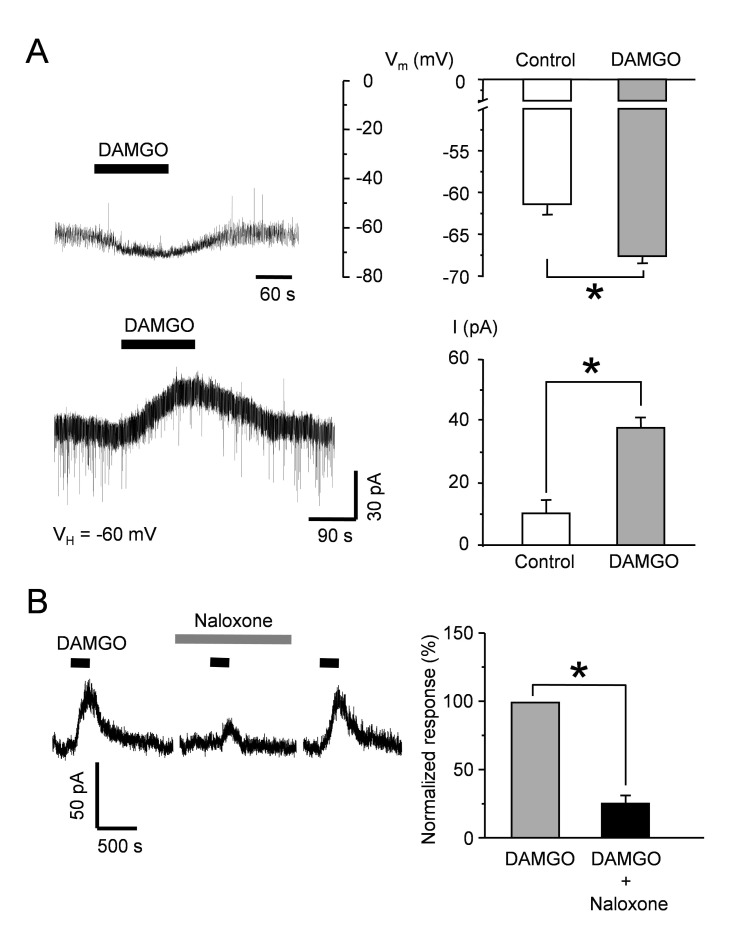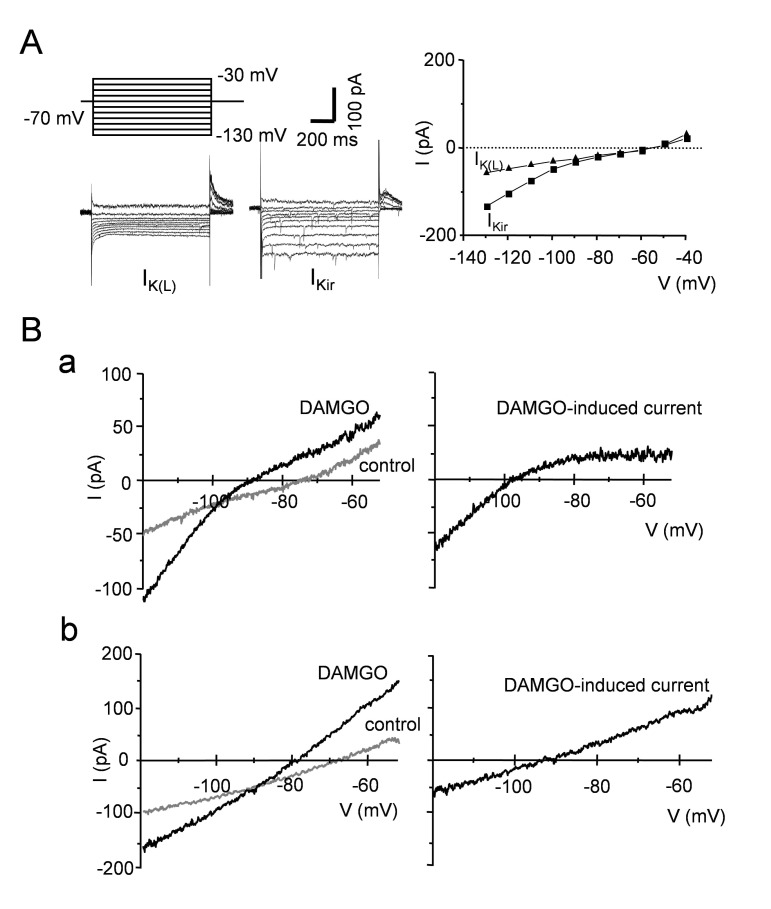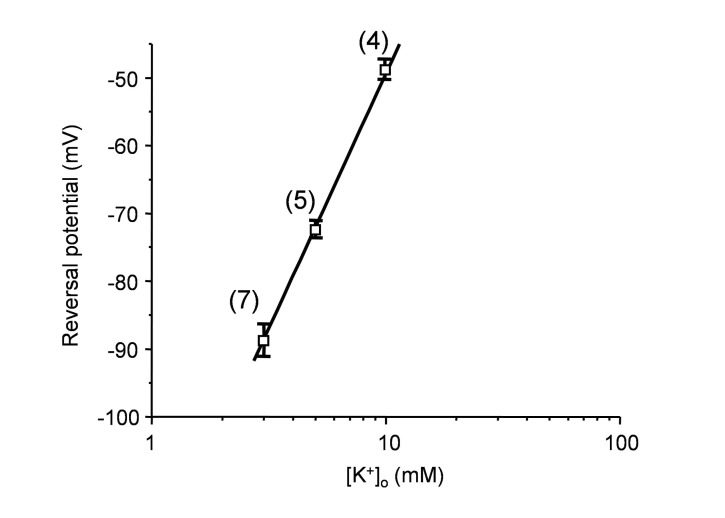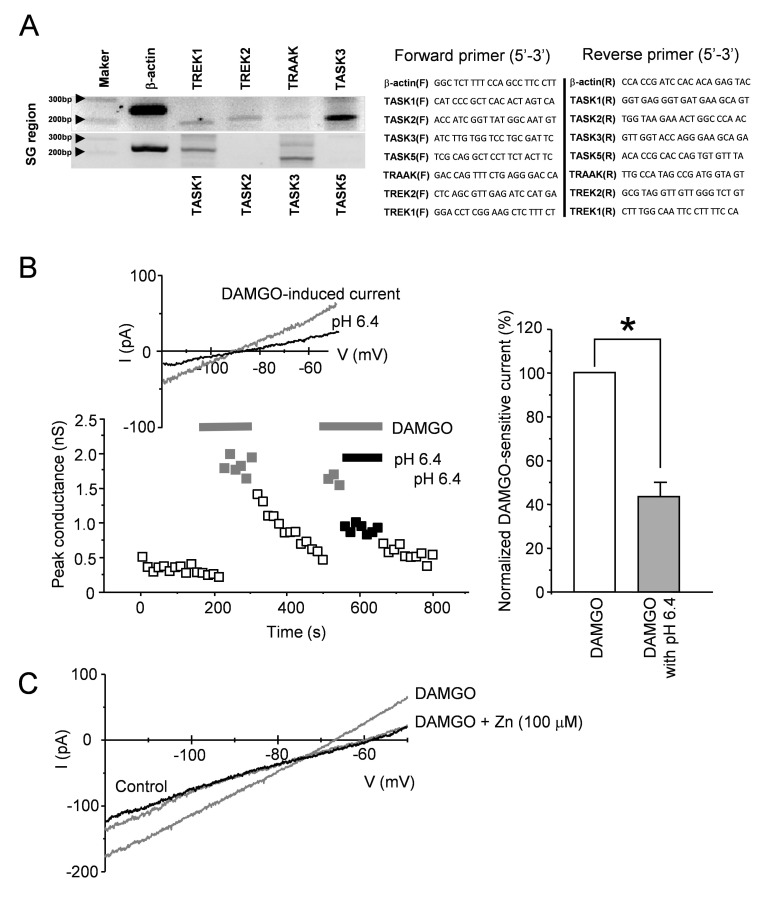Korean J Physiol Pharmacol.
2016 Sep;20(5):525-531. 10.4196/kjpp.2016.20.5.525.
DAMGO modulates two-pore domain K⺠channels in the substantia gelatinosa neurons of rat spinal cord
- Affiliations
-
- 1Department of Biomedical Science, Graduate School of Biomedical Science; Engineering, Hanyang University, Seoul 04763, Korea. eurijj@hanyang.ac.kr
- KMID: 2350509
- DOI: http://doi.org/10.4196/kjpp.2016.20.5.525
Abstract
- The analgesic mechanism of opioids is known to decrease the excitability of substantia gelatinosa (SG) neurons receiving the synaptic inputs from primary nociceptive afferent fiber by increasing inwardly rectifying K⺠current. In this study, we examined whether a µ-opioid agonist, [D-Ala2,N-Me-Phe4, Gly5-ol]-enkephalin (DAMGO), affects the two-pore domain K⺠channel (K2P) current in rat SG neurons using a slice whole-cell patch clamp technique. Also we confirmed which subtypes of K2P channels were associated with DAMGO-induced currents, measuring the expression of K2P channel in whole spinal cord and SG region. DAMGO caused a robust hyperpolarization and outward current in the SG neurons, which developed almost instantaneously and did not show any time-dependent inactivation. Half of the SG neurons exhibited a linear I~V relationship of the DAMGO-induced current, whereas rest of the neurons displayed inward rectification. In SG neurons with a linear I~V relationship of DAMGO-induced current, the reversal potential was close to the K⺠equilibrium potentials. The mRNA expression of TWIK (tandem of pore domains in a weak inwardly rectifying K⺠channel) related acid-sensitive K⺠channel (TASK) 1 and 3 was found in the SG region and a low pH (6.4) significantly blocked the DAMGO-induced K⺠current. Taken together, the DAMGO-induced hyperpolarization at resting membrane potential and subsequent decrease in excitability of SG neurons can be carried by the two-pore domain K⺠channel (TASK1 and 3) in addition to inwardly rectifying K⺠channel.
Keyword
MeSH Terms
Figure
Reference
-
1. Kumazawa T, Perl ER. Excitation of marginal and substantia gelatinosa neurons in the primate spinal cord: indications of their place in dorsal horn functional organization. J Comp Neurol. 1978; 177:417–434. PMID: 412881.
Article2. Yoshimura M, Jessell TM. Membrane properties of rat substantia gelatinosa neurons in vitro. J Neurophysiol. 1989; 62:109–118. PMID: 2754464.
Article3. Merchenthaler I, Maderdrut JL, Altschuler RA, Petrusz P. Immunocytochemical localization of proenkephalin-derived peptides in the central nervous system of the rat. Neuroscience. 1986; 17:325–348. PMID: 3517687.
Article4. Besse D, Lombard MC, Zajac JM, Roques BP, Besson JM. Pre- and postsynaptic distribution of mu, delta and kappa opioid receptors in the superficial layers of the cervical dorsal horn of the rat spinal cord. Brain Res. 1990; 521:15–22. PMID: 2169958.5. Gouardères C, Beaudet A, Zajac JM, Cros J, Quirion R. High resolution radioautographic localization of [125I]FK-33-824-labelled mu opioid receptors in the spinal cord of normal and deafferented rats. Neuroscience. 1991; 43:197–209. PMID: 1717884.
Article6. Faull RL, Villiger JW. Opiate receptors in the human spinal cord: a detailed anatomical study comparing the autoradiographic localization of [3H]diprenorphine binding sites with the laminar pattern of substance P, myelin and nissl staining. Neuroscience. 1987; 20:395–407. PMID: 2438589.
Article7. Yoshimura M, North RA. Substantia gelatinosa neurones hyperpolarized in vitro by enkephalin. Nature. 1983; 305:529–530. PMID: 6621700.
Article8. Grudt TJ, Williams JT. mu-Opioid agonists inhibit spinal trigeminal substantia gelatinosa neurons in guinea pig and rat. J Neurosci. 1994; 14:1646–1654. PMID: 8126561.
Article9. Schneider SP, Eckert WA 3rd, Light AR. Opioid-activated postsynaptic, inward rectifying potassium currents in whole cell recordings in substantia gelatinosa neurons. J Neurophysiol. 1998; 80:2954–2962. PMID: 9862898.
Article10. Rusin KI, Moises HC. mu-Opioid receptor activation reduces multiple components of high-threshold calcium current in rat sensory neurons. J Neurosci. 1995; 15:4315–4327. PMID: 7540671.11. Taddese A, Nah SY, McCleskey EW. Selective opioid inhibition of small nociceptive neurons. Science. 1995; 270:1366–1369. PMID: 7481826.
Article12. Seol GH, Kim J, Cho SH, Kim WK, Kim JW, Kim SJ. The inhibitory effect of opioid on the hyperpolarization-activated cation currents in rat substantia gelatinosa neurons. Korean J Physiol Pharmacol. 2001; 5:373–380.13. Enyedi P, Czirják G. Molecular background of leak K+ currents: two-pore domain potassium channels. Physiol Rev. 2010; 90:559–605. PMID: 20393194.14. Goldstein SA, Bockenhauer D, O'Kelly I, Zilberberg N. Potassium leak channels and the KCNK family of two-P-domain subunits. Nat Rev Neurosci. 2001; 2:175–184. PMID: 11256078.
Article15. Blankenship ML, Coyle DE, Baccei ML. Transcriptional expression of voltage-gated Na+ and voltage-independent K+ channels in the developing rat superficial dorsal horn. Neuroscience. 2013; 231:305–314. PMID: 23219908.16. Duprat F, Lesage F, Fink M, Reyes R, Heurteaux C, Lazdunski M. TASK, a human background K+ channel to sense external pH variations near physiological pH. EMBO J. 1997; 16:5464–5471. PMID: 9312005.17. Ribeiro-da-Silva A, Pioro EP, Cuello AC. Substance P- and enkephalin-like immunoreactivities are colocalized in certain neurons of the substantia gelatinosa of the rat spinal cord: an ultrastructural double-labeling study. J Neurosci. 1991; 11:1068–1080. PMID: 1707094.
Article18. Arvidsson U, Dado RJ, Riedl M, Lee JH, Law PY, Loh HH, Elde R, Wessendorf MW. delta-Opioid receptor immunoreactivity: distribution in brainstem and spinal cord, and relationship to biogenic amines and enkephalin. J Neurosci. 1995; 15:1215–1235. PMID: 7532700.
Article19. Arvidsson U, Riedl M, Chakrabarti S, Lee JH, Nakano AH, Dado RJ, Loh HH, Law PY, Wessendorf MW, Elde R. Distribution and targeting of a mu-opioid receptor (MOR1) in brain and spinal cord. J Neurosci. 1995; 15:3328–3341. PMID: 7751913.
Article20. Kemp T, Spike RC, Watt C, Todd AJ. The mu-opioid receptor (MOR1) is mainly restricted to neurons that do not contain GABA or glycine in the superficial dorsal horn of the rat spinal cord. Neuroscience. 1996; 75:1231–1238. PMID: 8938756.21. Kerchner GA, Zhuo M. Presynaptic suppression of dorsal horn inhibitory transmission by mu-opioid receptors. J Neurophysiol. 2002; 88:520–522. PMID: 12091574.22. Glaum SR, Miller RJ, Hammond DL. Inhibitory actions of delta 1-, delta 2-, and mu-opioid receptor agonists on excitatory transmission in lamina II neurons of adult rat spinal cord. J Neurosci. 1994; 14:4965–4971. PMID: 8046463.
Article23. Talley EM, Lei Q, Sirois JE, Bayliss DA. TASK-1, a two-pore domain K+ channel, is modulated by multiple neurotransmitters in motoneurons. Neuron. 2000; 25:399–410. PMID: 10719894.24. Berg AP, Talley EM, Manger JP, Bayliss DA. Motoneurons express heteromeric TWIK-related acid-sensitive K+ (TASK) channels containing TASK-1 (KCNK3) and TASK-3 (KCNK9) subunits. J Neurosci. 2004; 24:6693–6702. PMID: 15282272.25. Kim Y, Bang H, Kim D. TASK-3, a new member of the tandem pore K+ channel family. J Biol Chem. 2000; 275:9340–9347. PMID: 10734076.26. Morton MJ, O'Connell AD, Sivaprasadarao A, Hunter M. Determinants of pH sensing in the two-pore domain K+ channels TASK-1 and -2. Pflugers Arch. 2003; 445:577–583. PMID: 12634929.27. Devilliers M, Busserolles J, Lolignier S, Deval E, Pereira V, Alloui A, Christin M, Mazet B, Delmas P, Noel J, Lazdunski M, Eschalier A. Activation of TREK-1 by morphine results in analgesia without adverse side effects. Nat Commun. 2013; 4:2941. PMID: 24346231.
Article28. Clarke CE, Veale EL, Green PJ, Meadows HJ, Mathie A. Selective block of the human 2-P domain potassium channel, TASK-3, and the native leak potassium current, IKSO, by zinc. J Physiol. 2004; 560:51–62. PMID: 15284350.
Article
- Full Text Links
- Actions
-
Cited
- CITED
-
- Close
- Share
- Similar articles
-
- The inhibitory effect of opioid on the hyperpolarization-activated cation currents in rat substantia gelatinosa neurons
- The effect of µ-opioid receptor activation on GABAergic neurons in the spinal dorsal horn
- Peripheral Nerve Injury Alters Excitatory and Inhibitory Synaptic Transmission in Rat Spinal Cord Substantia Gelatinosa
- Ryanodine Receptor-mediated Calcium Release Regulates Neuronal Excitability in Rat Spinal Substantia Gelatinosa Neurons
- Effects of Reactive Oxygen Species and Nitrogen Species on the Excitability of Spinal Substantia Gelatinosa Neurons





